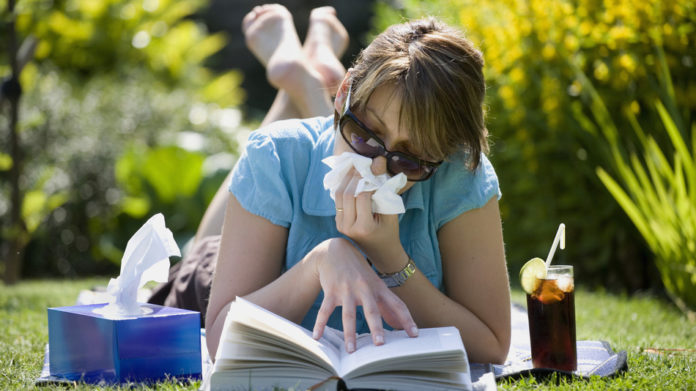‘Pollen Tsunami’ is real and it’s awful

You’re tired. Your eyes are watery and itchy. Your head feels like it’s stuffed with cotton. And you can’t stop sneezing.
Blame the weather. Blame climate change. Blame your allergies. But most of all, blame the “pollen tsunami” that’s making headlines in New York City.
Pollen is the yellow and green dust you see all over your car and on basically every other object exposed to the elements right now. Male trees and flowers produce it in the spring to fertilize their female counterparts, which will produce seeds to grow more plants and produce more pollen.
Yes, it’s a vicious cycle.
If it seems like there’s more of the yellow stuff than usual and your symptoms are more intense, you’re probably not imagining things. In the northeast, the delayed onset of spring may have stalled early pollen production only to have it kick off at the same time as regular spring pollen and — wait for it — grass pollen.
New York City Allergist Dr. Clifford Bassett calls it “Triple Pollens” or, the term that makes the rounds every time there’s an intense explosion of these allergens: pollen tsunami.
Basset, who is the medical director of Allergy and Asthma Care of NY and on the faculties of NYU School of Medicine and Cornell University Medical College, told Mashable that this problem is not just confined to the Northeast, it’s affecting the entire country.
Bassett contends that it’s not just bad luck that’s bringing all this pollen.
“We’re seeing longer pollen seasons, starting earlier and lasting longer,” Dr. Basset said. He points to climate change and urbanization as potential culprits. “Yes, what we’ve seen is an escalation in pollen misery over the past several decades….Over the last 100 years, an urbanization around the world is one of the reasons we’re seeing indirectly more allergies.”
On the climate change front, at least, he has some support.
A 2014 scientific study on climate change’s impact on pollen levels found that pollen season now starts three days earlier than it did in the 1990s and that annual total of daily airborne pollen counts increased 46% in that same period.
“These changes are likely due to recent climate change and particularly the enhanced warming and precipitation at higher latitudes in the contiguous United States,” the abstract for the report says.
One of the authors of that report, allergist, immunologist and an expert at Rutgers University’s Center for Environmental Prediction, Dr. Leonard Bielory, told Mashable that tsunami may not be the best descriptor.
“Tsunami is a pretty strong term. I’ve been using the term the ‘perfect storm,'” Dr. Bielory said.
In the Northeast, he explained, tree pollens that might normally release over the course of months were all delayed by the cold winter and spring. Now they’re releasing at the same time as grass pollen.
As a result “there are thousands of pollen grains per cubic meter of air,” said Dr. Bielory. As for how urban sprawl might impact the pollen count, Bielory is unconvinced. He said more tarmac and fewer plants could lead to more pollution, which could exacerbate the impact of pollen — at any level.
He also said the situation is only going to get worse. In Bielory’s study, they looked at 30 years of pollen trends to predict the future. Pollen counts will, he said, rise 20% by 2020, and even more over the next 25 years.
Is climate change to blame? To some extent, yes, said Bielory, but he cautioned that “climate change” is not about today or tomorrow’s weather report: It’s significant change over decades and even centuries.

The national Climatic Data Center Statewide Average Temperature Ranks for the first four months of 2015.
Image: NOAA
The National Climatic Data Center’s statewide average temperature report for January through April shows near-record cold temperatures for much of the Northeast and record warm conditions across the West. While the cold might account for the delayed pollen release, it’s the increasing warmth in the West that may be generating even more or earlier pollen releases.
Essentially, the news on the pollen front just isn’t good.
Naturally, though, Dr. Bassett believes allergies are “totally treatable.” He offered us a few tips for surviving the next few weeks.
-
Wear sunglasses: They might block pollen from reaching your eyes.
-
Exercise indoors: You can also shift your exercise routine to the morning, when pollen counts are lower.
-
Know the pollen count: You can get it from the news and also know that it’s highest on windy, dry and sunny days.
-
Take your meds: Take allergy medicine before symptoms start.
-
Tea: Some think green tea can help fight the effects of tree pollen.
-
Shower at night: You can clean the allergens off your skin and out of your hair, thereby keeping them out of your bedroom.
-
Eye care: Gently rinse your eyelids (with your eyes closed) to get rid of accumulated allergens.
-
Clear the air: Close your windows, turn on your air conditioner and let its filters do the work.
Have something to add to this story? Share it in the comments.
